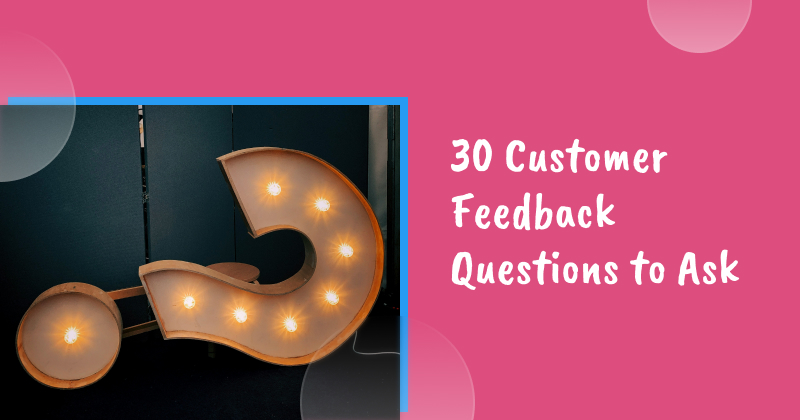Customer feedback is the process of collecting, evaluating, and acting on the insights that your customers share. These can include learning about their thoughts, feelings, wants, needs, and overall experience of your brand.
But to get the golden insights, you need to ask the right customer feedback questions—which is often a challenge.
If you don’t know where to start on collecting customer feedback, don’t sweat it! We’ve got everything you need to undertake customer research and get an in-depth look into your audience.
Read on for some great customer feedback survey questions.
Shortcuts ✂️
- Questions to understand your customers
- Questions to improve your website
- Questions to improve your product or service
- Questions to improve your customer service experience
- Questions to improve your marketing strategy
- Questions to understand the purchase experience
- When are the best times to display customer feedback surveys?
- Where to ask for feedback to improve customer satisfaction?
- 6 best tools to collect customer feedback
Customer feedback questions to understand your customers
Your existing customers are often demographically and motivationally similar to your prospects.
So you can use this data to understand and attract more potential customers. It will help you boost conversions and grow your revenue.
Let’s take a look at some of the best customer feedback questions to understand your customers!
1. What is your age?
This question allows you to understand and segment your audience. People of different age groups use different channels to find information and make purchases—from chatbots to phone lines.
If you find that most of your customers are in a particular age group, you can focus your marketing efforts on their go-to channels.
For example, if your target audience is Gen Z—concentrate on TikTok and Instagram.
2. What is your marital status?
This question allows you to understand your customers’ priorities.
Single people will likely have different priorities than people with kids. Their purchasing behavior will vary too.
3. What is your household income?
You can use this question to understand more about your customers’ spending habits. Since there’s an obvious correlation between how much they earn and what they can afford and are willing to spend.
Let respondents choose from ranges. And make sure to include a “prefer not to answer” option.
4. What is your current employment status?
Ask this question to determine the best times and places to target your customers.
For instance, if the majority of your customers run their own businesses, the best platform to reach them is LinkedIn Ads instead of Facebook/TikTok Ads.
5. What challenge or problem does our business/product solve for you?
This question enables you to understand accurately the challenges your business solves for loyal customers.
Use this information to discover (and target) other prospects with the same problems and pain points.
Customer feedback questions to improve your website
Your website is usually the first place your customers visit to research your products or services. Therefore, you should offer a smooth and seamless user experience.
HubSpot reports that 76% of customers rank ease of use as the most important characteristic of a good website.
Your customers will interact multiple times with your website throughout their customer journey. This is a great opportunity to display a customer feedback survey about their user experience.
Here are the best customer feedback questions to ask if you want to improve your website.
6. Where did you first hear about us?
Tools like Google Analytics and your Marketing Automation Platform (MAP) will help you understand your incoming traffic on a macro level. But that’s just the information on their last interaction with your website.
Often, analytics platforms don’t provide details on where and how a visitor found your company website and why they’re there on that particular day.
So this question helps you identify and choose the best channels to invest your marketing budget in.
7. What is the goal of your visit today?
Ask this question to understand your individual visitors on a more personal level, so you can segment them for future re-targeting and nurturing campaigns.
You can also use your visitors’ answers to guide them to the information and content they truly need.
The faster you can help your visitors find what they are looking for, the sooner you can convert them into active users or customers.
8. Did this article answer all of your questions?
This question helps you find out whether your article is meeting your readers’ needs or not.
Customer success teams invest a lot of time into creating helpful content for their users. However, it’s hard to know which information is the most useful.
Just ask this question at the end of each article. It will show your team how to create the most relevant, timely, and useful information for your visitors.
9. Did you find the information you were looking for on this page?
Use this question on your most essential web pages—like:
- Your homepage
- Your FAQs page
- Your pricing page
- Product pages
- Features page, etc.
You’ll find out if your pages are informative, easy to use, and navigate. This helps you uncover any flaws that may be spiking your bounce rates (the number of people that leave your site without taking action).
10. What made you exit the website?
Invesp reported that the average ecommerce website conversion rate is 2.58%. This means that more than 97% of visitors will leave your site without buying.
Why do people abandon their carts?
There are many reasons—load time, speed, off-putting branding, or maybe your visitor just can’t find the information they need.
Customer feedback questions to improve your product or service
How well do your products or services meet your customers’ needs, wants, and expectations? Use these customer feedback questions to find out.
11. How satisfied are you with our products or services?
Pair this question with a rating scale and an extra text box for them to explain further. This gives your customers a chance to provide in-depth feedback on what is and isn’t working.
12. Why did you choose us over other options in the marketplace?
Most buyers weigh up different stores when shopping for a product. By asking this question, you can understand what your competitors are and aren’t doing well.
You’ll also learn how you can differentiate yourself from your competitors.
13. What is your main goal for using this product?
Use this question to understand the actual pain point or problem your customers are trying to solve.
You can use this information to enhance your product, your knowledge base, marketing materials, sales pages, and more.
You can also leverage this information to find, target, market, and sell to other customers looking to solve the same problem.
14. If you could change one thing about our product/service, what would it be?
This question gives your customers the chance to provide you with actionable ideas. It will also highlight the biggest issues with your offers and what you need to upgrade.
15. If there’s one thing our product does better than others, what is it?
Use this question to understand your Unique Selling Proposition (USP)—what makes your brand and your product unique and desirable for your customers.
Many companies try to define their USP, but their definition can be different from what their clients see as the most unique thing about their brand.
Identifying your USP based on your customers’ vantage point will help build your brand and drive conversions.
Customer feedback questions to improve your customer service experience
Your customer experience covers every interaction your customer has with your brand—from phone calls with your team to making their way through checkout.
Each experience is totally unique and personal to your customers, but you can use strategies to optimize their customer journey.
Here are the best customer feedback questions to find out how customers experience your brand and how you can level up the customer service experience.
16. Is our product or service meeting your goals?
The optimal method to determine if your product is performing effectively during its job trial is to directly inquire with your customers. They are likely to offer candid feedback.
Here’s what to do based on their answers:
If the majority says yes, it’s an excellent opportunity to upsell them on a related product. You can also ask them for reviews or referrals. This is awesome social proof for selling your products or services.
If they answer no, take this chance to understand why your solution isn’t meeting your customers’ goals.
17. How satisfied are you with our customer service?
Find out more about your customers’ experience with your support staff.
Use this question to identify the most effective channels to communicate with your customers (email, phone, live chat, social media) and how best to support them.
18. What suggestions do you have to improve your experience with our company?
This is another great customer service feedback question. It’s open-ended and will give you tons of ideas on how to improve your services, workflow, processes, and even people.
19. What are a few words you’d use to describe our service?
Your customers will tell you exactly how they perceive your brand. This can give you some inspiration for shaping your brand as you move forward.
20. How likely are you to recommend our product to your friends or colleagues?
In a hyper-connected world, word-of-mouth marketing is still one of the most cost-effective forms of acquiring new customers.
If your customers love your product, they’re more likely to recommend it to their family and friends.
If people express satisfaction in their answers, leverage this positive interaction to create case studies, testimonials, and reviews.
Customer feedback questions to improve your marketing strategy
According to HubSpot, the average cost-per-lead (CPL) is around $200. In some industries, such as information technology, it can be as high as $370.
As the competition to capture your audience’s attention grows, so does the cost to acquire new customers.
One effective way to reduce your CPL is to improve your customer acquisition costs (CAC). You can optimize your marketing spend by surveying your customers regularly.
Feedback from your new and existing customers will help you pinpoint your most effective and profitable marketing channels.
Here are some customer feedback questions if you want to improve your marketing message and marketing strategy.
21. How did you hear about us?
Like most ecommerce companies, you likely divide your marketing dollars into various channels. But do you know which one is the most successful and cost-effective?
Analytics tools are useful, but interviewing your customers is the best way to find out. Use this question to spot the best marketing channels for your business.
22. Why did you choose us?
This is an ideal question for new customers. Discover the main reasons why they decided to buy from you.
Dig deep into the value you offer—your product listings, product descriptions, purchasing process, payment options, customer service, etc.
23. What do you like about our content, and what would you like us to improve?
Content marketing continues to be a significant source of traffic and leads for many websites and ecommerce companies.
Ask this specific question to improve your blog, social media, and newsletter.
Your customers will tell you exactly the type of content and resources they want to see on your website.
24. What specifically motivated you to evaluate our solution?
Your customer typically goes through multiple touchpoints with your company before they are ready to purchase.
If you can pinpoint the exact email, blog post, or campaign that motivated them to start a trial or consider your product, you can double down on that strategy moving forward.
For example, if one of your email sequences was a huge hit, you can create similar sequences in the future.
25. What’s stopping you from buying our product?
What are your customers’ biggest objections and barriers to buying? Find out with one of the best product feedback questions.
Your marketing materials should address your customers’ biggest anxieties.
Tackle them head-on and introduce risk-reducers (like 30-day money-back guarantees or free shipping) to help boost your sales.
Customer feedback questions to understand the purchase experience
If your purchasing process is relatively easy and frictionless, your customers will be more likely to buy. Let’s take a look at the most effective customer feedback questions you can ask to improve this key area of your business.
26. Was it easy to find what you were looking for?
Ask this question during the first visit to your website via a popup survey. It helps to understand your customers’ experience and make improvements accordingly.
27. Was it easy to purchase your item or service?
According to the Baymard Institute, website visitors abandon shopping cart pages about 69% of the time. This causes a huge loss in revenue. Now it’s time to uncover the gaps in your checkout or sales process.
So you can fix them immediately and optimize your customer’s experience on your checkout page.
28. Did you feel comfortable shopping with us?
This emotion-based customer feedback question invites your buyers to open up about the positive and the more challenging aspects of their purchasing journey.
Discover how you can improve overall satisfaction during their shopping experience—from a faster checkout to more social proof—like testimonials.
29. How likely are you to buy from our store again?
According to ZenDesk, 52% of customers will make a repeat purchase if they’ve had a positive experience with a company. That’s why asking this question is important.
If the answer is a yes, you can upsell to the same customers by promoting relevant, more expensive products that are similar to their previous purchases. Think: a newer version of the iPhone.
This approach can boost your average order value and increase your LTV (lifetime value), which refers to how much revenue you generate from a single customer.
30. What was the best part about purchasing from our company?
Understand exactly why customers are purchasing from you. Their favorite thing about your brand or solution could be related to your products, reduced shipping costs, or convenient payment options. You can offer the same positive features to new customers.
When are the best times to display customer feedback surveys?
There’s no perfect time to display a customer feedback survey. It would be best if you asked customer feedback questions throughout the entire customer journey.
A typical ecommerce customer journey looks like this:
- Search: the customer searches for a solution.
- Discovery: they find multiple options.
- Evaluation: they evaluate and compare their options to identify the best one for them.
- Ordering: they make a purchase.
- Delivery: the product is delivered to them.
- Usage: they use the product.
- Repeat transactions: if they’re happy, they will buy more.
- Referrals/reviews: if they’re satisfied, they will share the good news or give the company referrals.
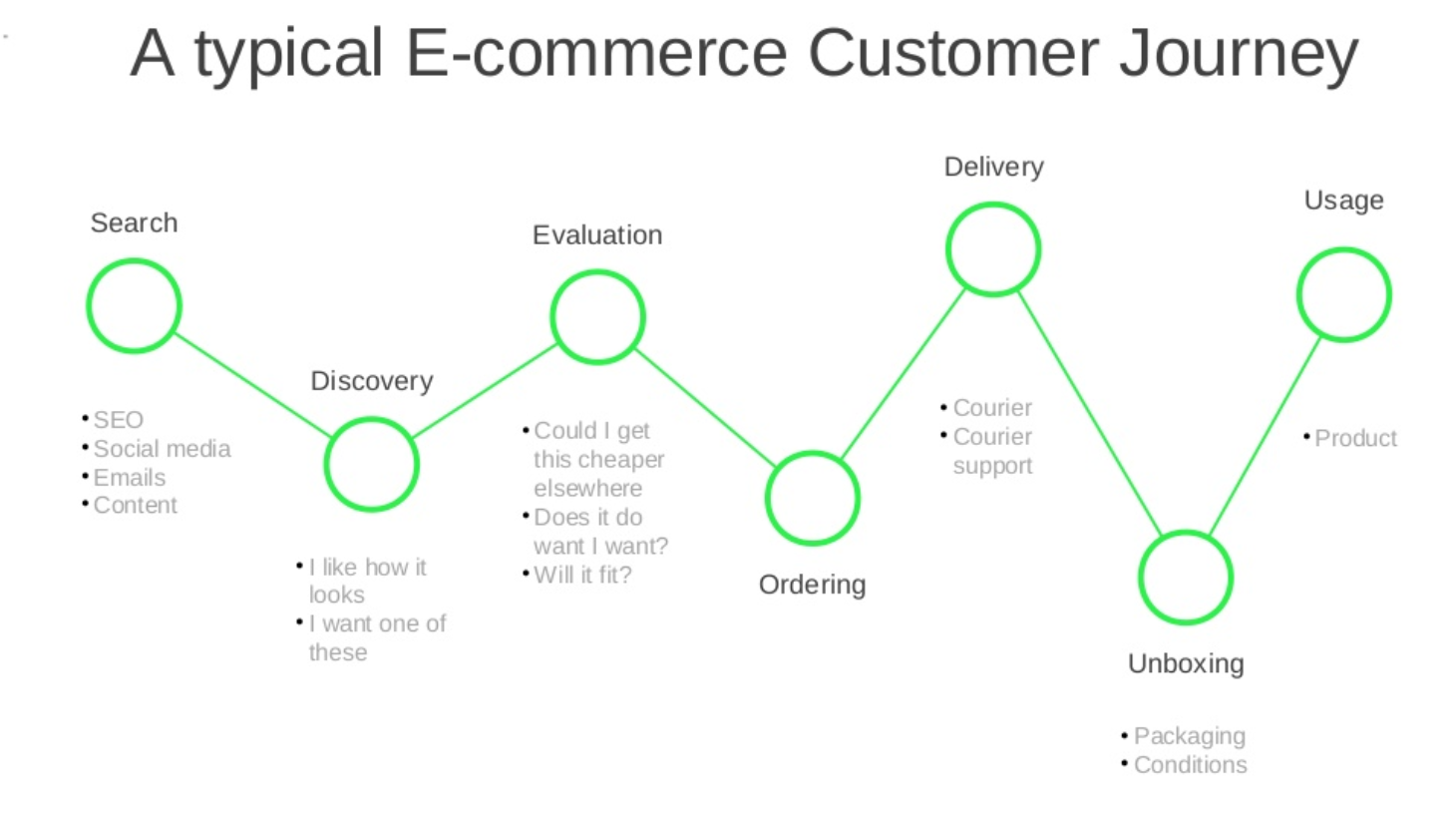
Source: Customer Experience for E-commerce
As you can see, there are many steps before someone becomes a customer.
All these individual steps are fantastic opportunities for you to engage with your visitors. And you can gain valuable insights into how to move them forward in the customer journey.
Now let’s see some examples of the best times to display your customer feedback questions.
1. Right after an interaction
Whether it’s on Instagram or in a conversation with a voicebot or chatbot, ask your potential customers for feedback right after you’ve helped them.
You want to discover what they found most and least helpful in their interaction with you.
Once an interaction is complete, you can also send them a short email survey to grade their experience.
2. Right after a purchase
Right after a visitor makes a purchase, you can immediately gain insights into why they bought from you.
The best way to do this is to send them a short email survey right after they pay. You can ask two or three questions on what motivated them to buy from your company.
3. Right after your customer receives your product
This is a great time to turn customer feedback into sales-generating testimonials because your buyers are still excited about their new item. To get their review, you can ask them: how satisfied are you?
Online reviews are paramount in ecommerce. According to Shopify, about 63% of consumers will purchase from a site that has product ratings and reviews.
Check out how Casper (an online mattress retailer) asked their customers to review their product:
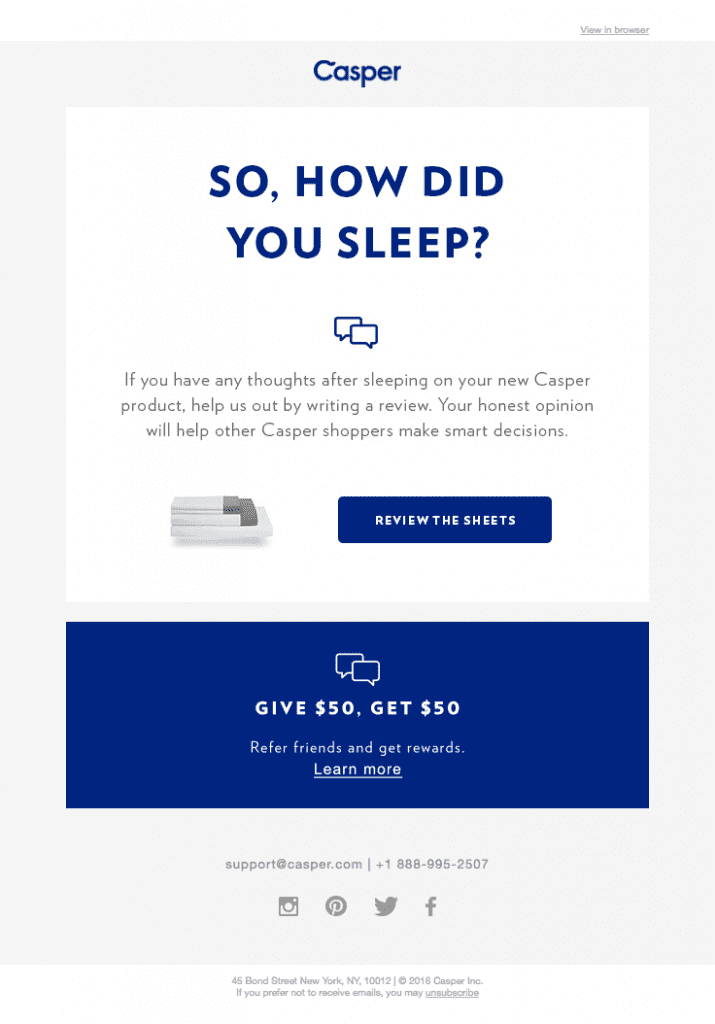
Source: Saluton Agency
4. When customers leave
Sometimes your customers may decide to cancel their order or return a product. It happens to the best of us.
However, this is also a great opportunity to learn why they are leaving. So ask them directly to find out what didn’t work in regards to your product, service, and user experience.
You can also use this data to retain visitors.
Here’s an example of a simple and effective email template from Groove. They received a response rate of 10.2% and were able to unveil product bugs and UX (user experience) issues.
The Groove team then used this information to fix those problems, and improve their customer retention rates.
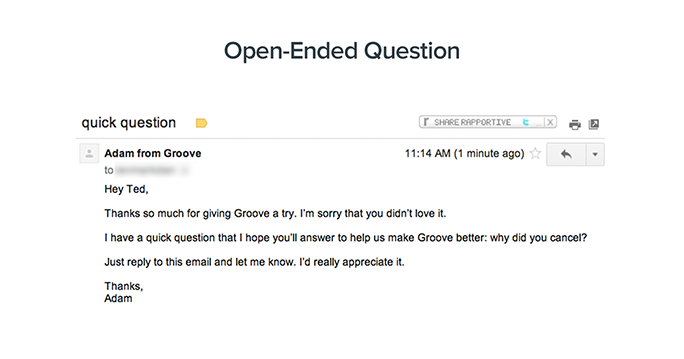
Source:Groove
5. When a customer abandons their cart
According to the Baymard Institute, the average ecommerce cart abandonment rate is 69.57%.
This means that close to 7 out of 10 customers will leave your store without buying anything. That’s a significant loss in potential sales.
There are many reasons why cart abandonment is so high for ecommerce stores:
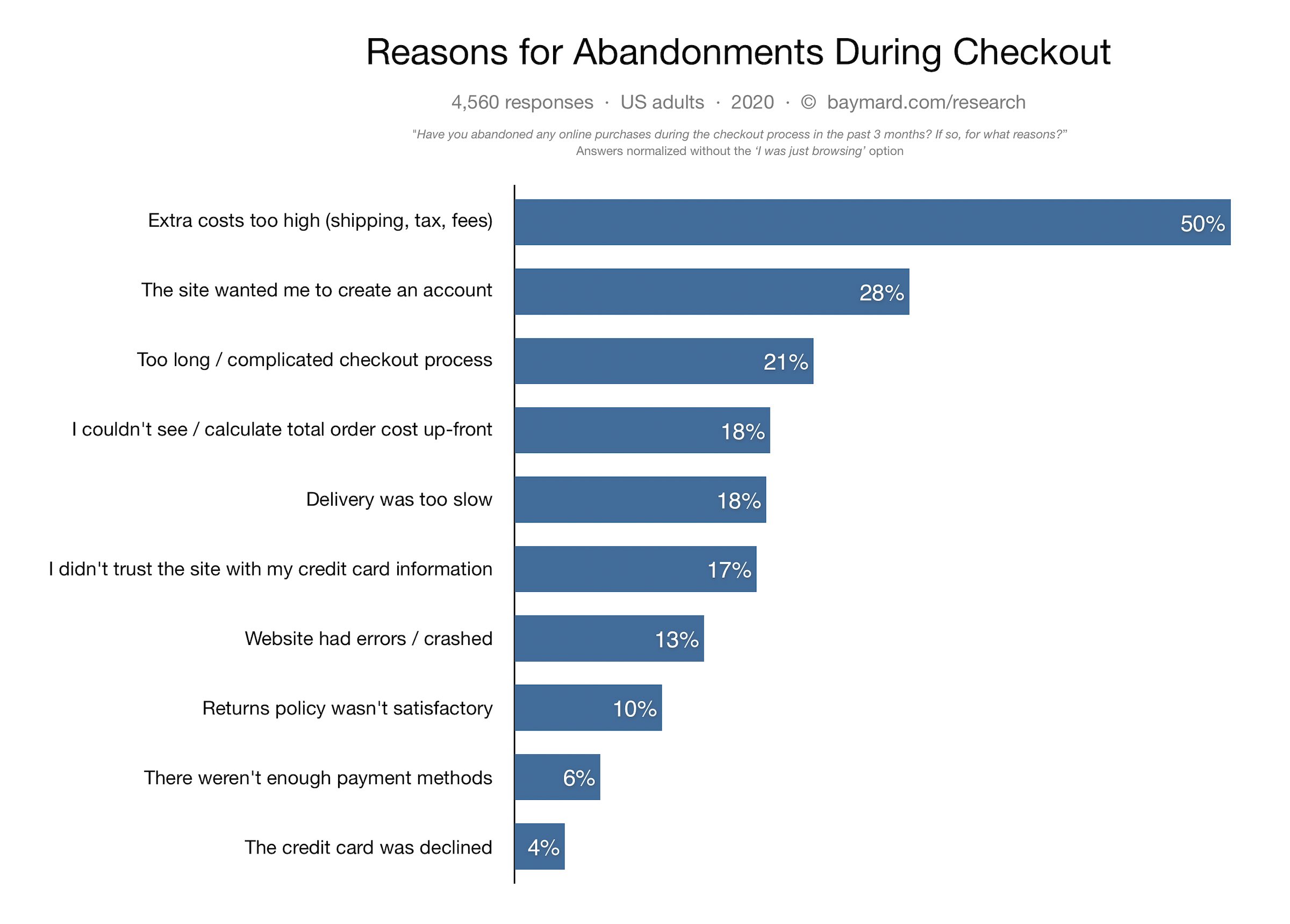
Source: Baymard Institute
You can use abandoned cart recovery emails to convert some customers. Or you can use follow-up emails to get valuable feedback on why they didn’t buy.
Here’s an example from Beardbrand. They used a simple email with open-ended questions to ask their shoppers why they left without purchasing. There’s also a link in the email that takes them back to their abandoned cart.
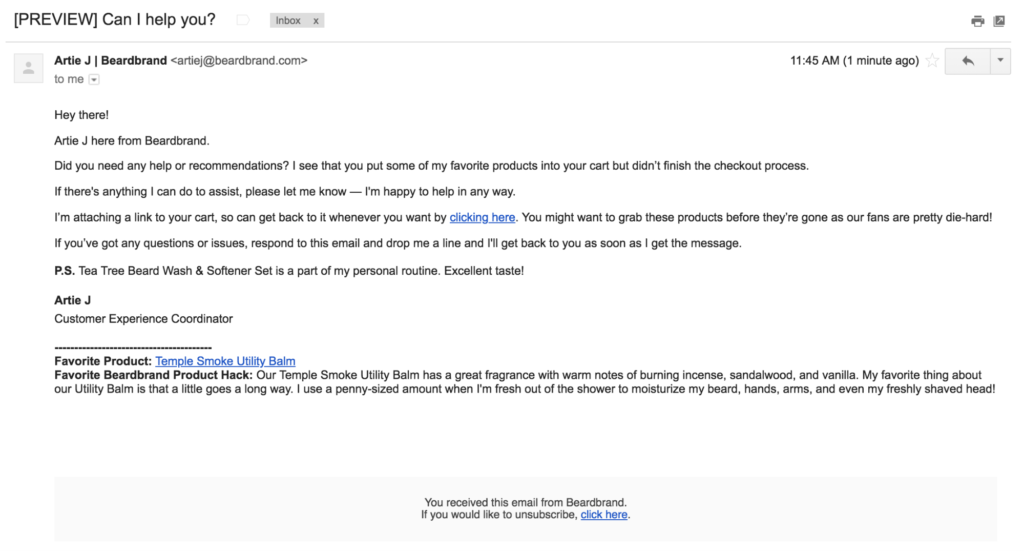
Where to ask for feedback to improve customer satisfaction?
Now you know when and how to ask for feedback. But where to ask (which channels) is equally important for getting tons of valuable answers from your visitors and customers.
1. On popups
Your prospects and customers visit your website for many reasons:
- To read product ratings and reviews.
- To compare you against your competitors.
- To find out your pricing.
- To read your blog content.
- To get information from your knowledge base.
- To make a purchase.
Each of these scenarios can provide an opportunity to collect valuable customer feedback.
The best way to do this on-site is with a beautifully-designed popup that doesn’t interfere with your visitors’ experience.
The great thing about popups is that they’re hard to miss and lead to high response rates.
You can use them to collect feedback when visitors browse your website to learn why they didn’t buy from you.
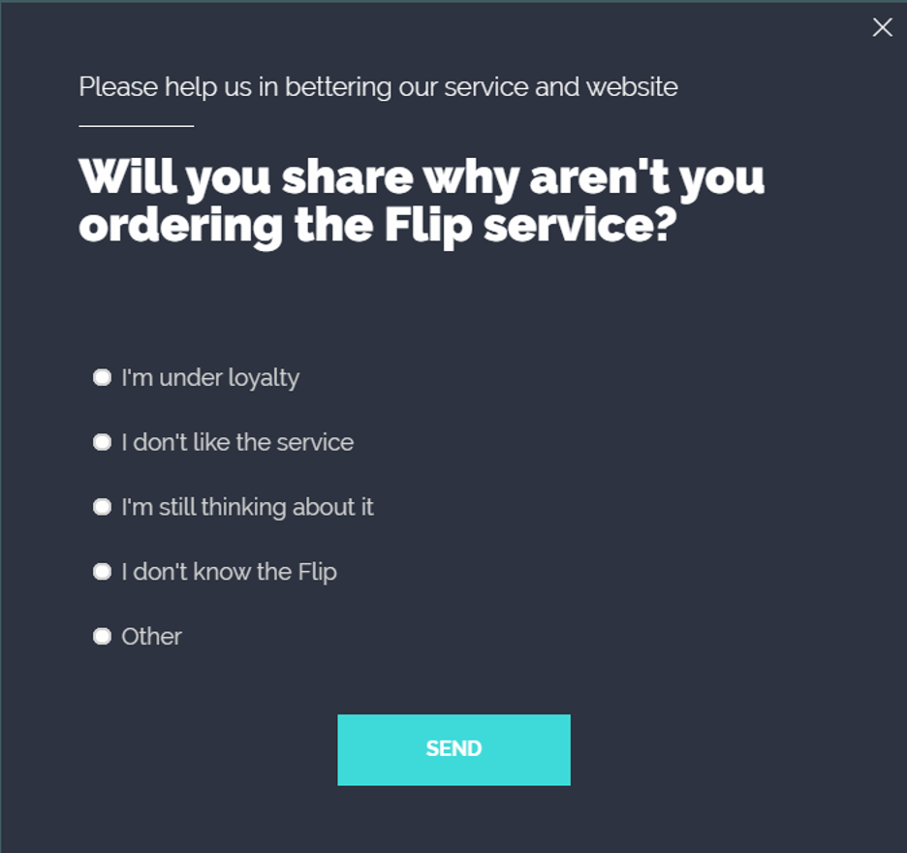
2. Via email
For ecommerce companies, email marketing provides one of the highest ROIs compared to other marketing channels. Emails are also an effective conversion and sales tool.
Besides, they’re useful for collecting feedback, especially for new customers.
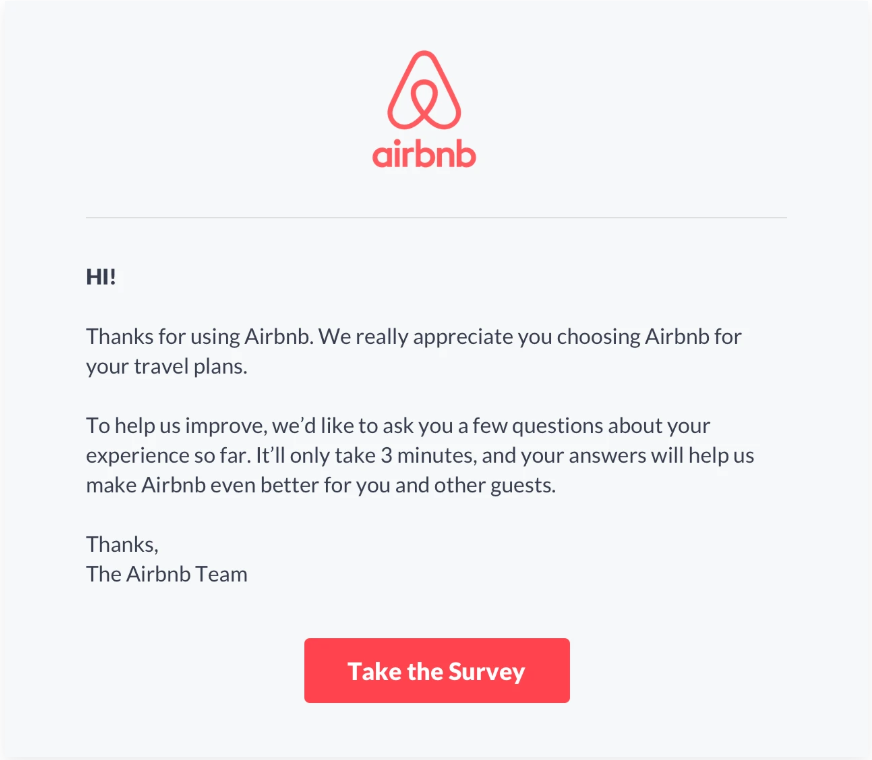
Source: Getsitecontrol.com
You can also use emails to collect product feature requests from your existing customers.
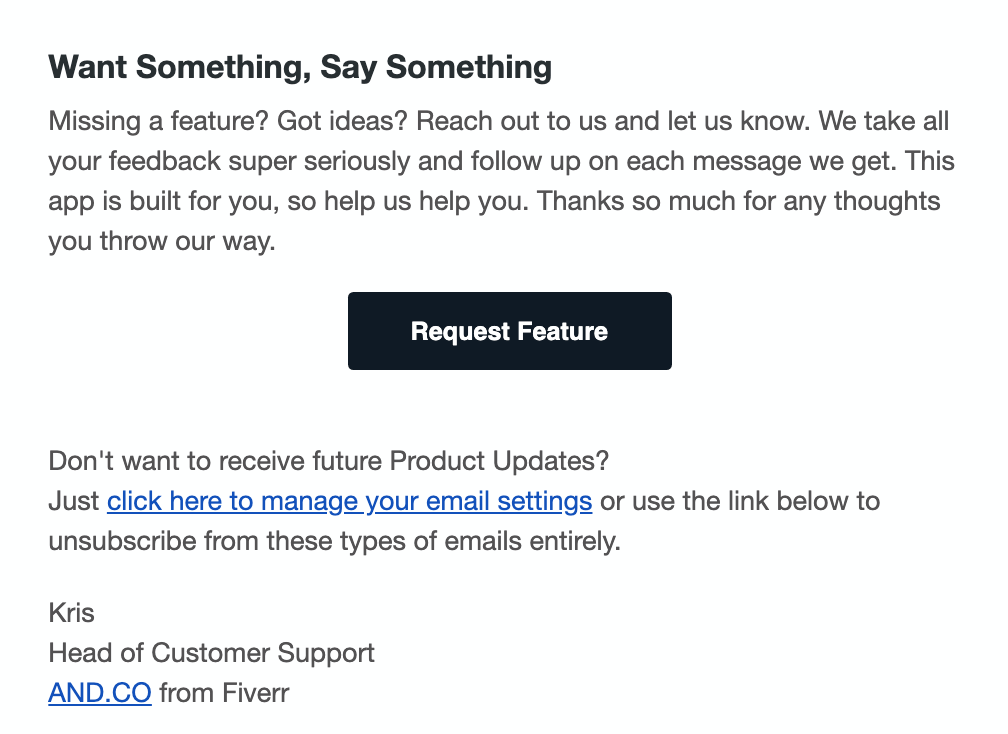
Source: Copper
3. Live chat
According to a survey by Harris Research, more than 53% of customers prefer live chats over phone calls.
Live chats are a brilliant means to collect customer feedback.
You can talk to your visitors without interrupting their browsing experience. It’s on their terms.
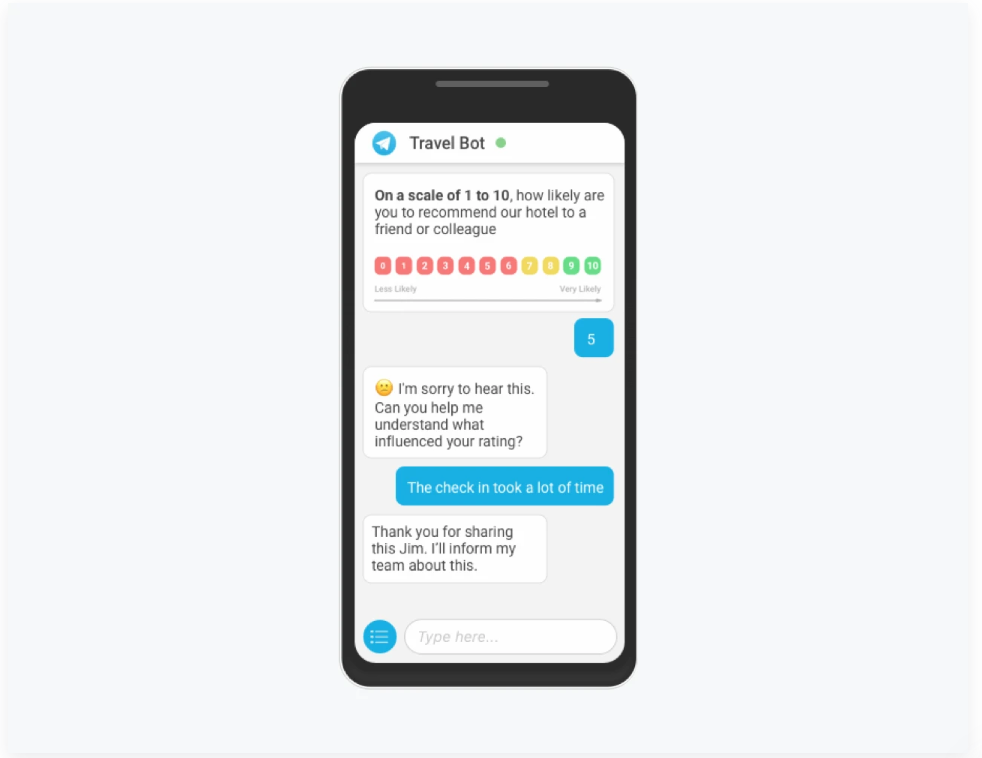
Source: GetSiteControl
Now that you know the best channels to collect customer feedback, let’s take a look at some of the best tools.
6 best tools to collect customer feedback
There are several tools you can use to simplify the customer feedback process. Let’s check them out.
1. OptiMonk
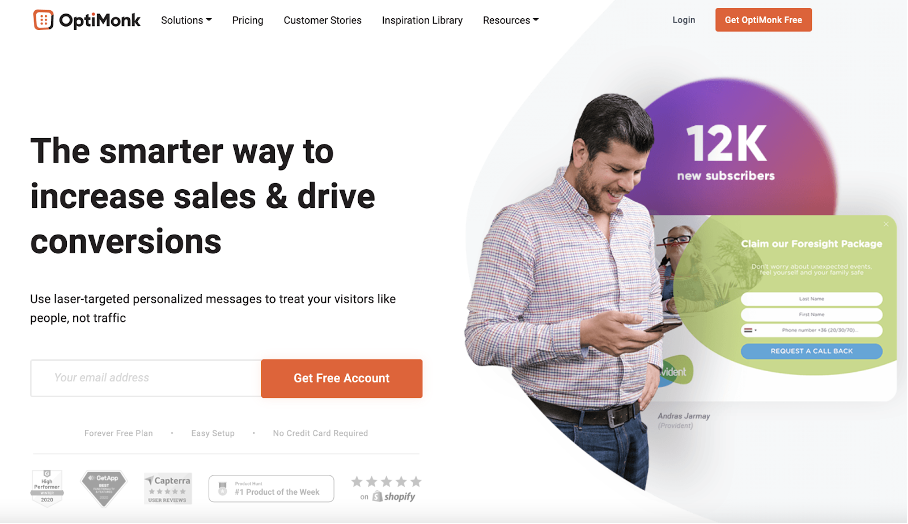
OptiMonk is a popup tool used by both online businesses and ecommerce stores. It helps brands boost their conversions and gain valuable feedback from website visitors and customers.
OptiMonk features:
- One-click surveys, radio buttons, multiple-choice questions, and custom-field questionnaires.
- 200+ pre-made templates that you can fully customize.
- Visual feedback dashboard to see the answers and review feedback items in real-time.
- Custom fields that can be added to your messages to collect additional client details (e.g. gender, date of birth, or country).
- Customize the flow according to your needs and add as many questions as you wish.
OptiMonk pricing:
- The Free plan allows websites to try out OptiMonk. There is no limit to the number of campaigns you can deploy using the Free plan.
- The Premium plans range from $29/month to $199/month.
- The pricing is based on the number of pageviews and additional features.
2. SurveyMonkey
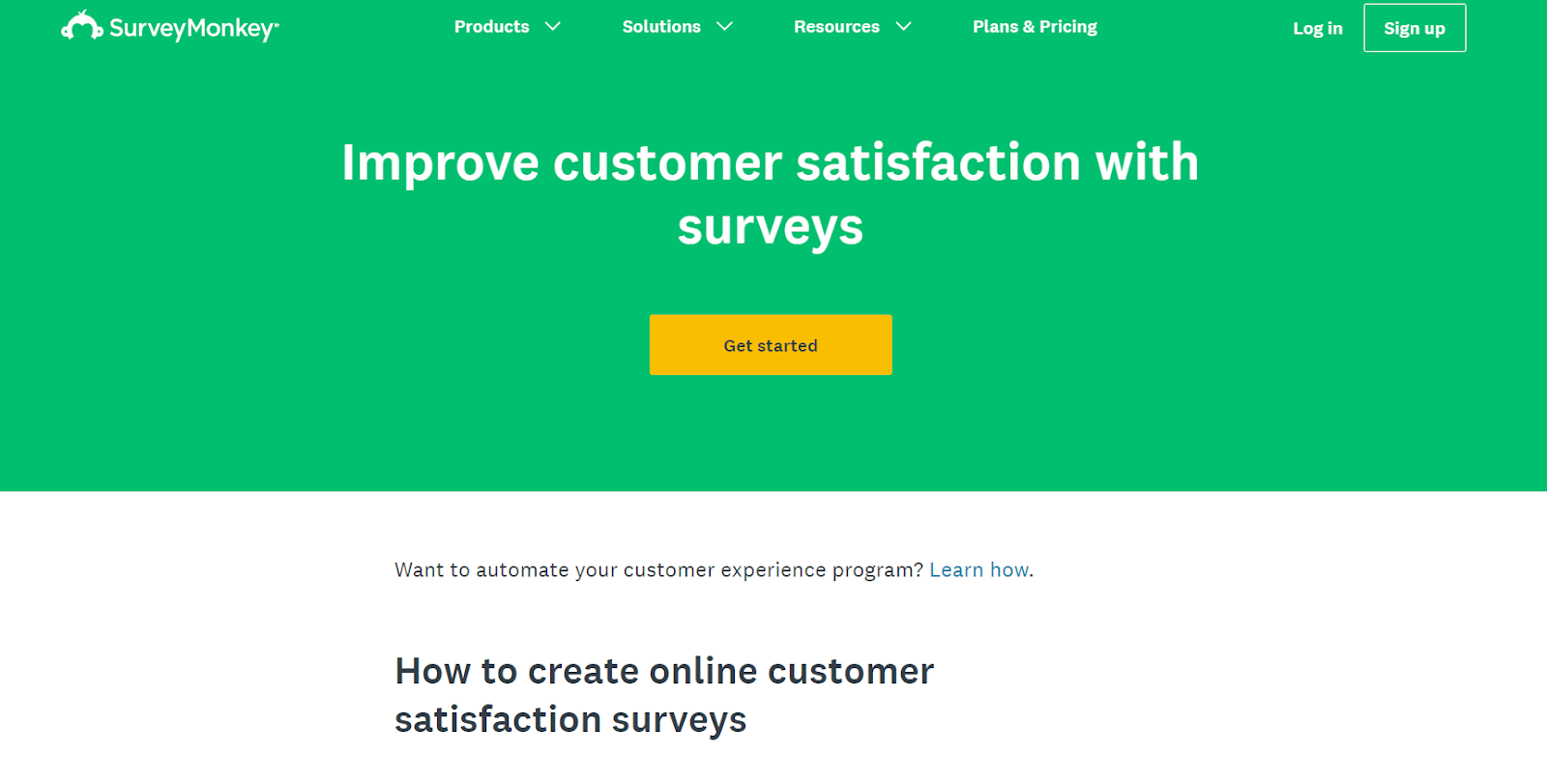
SurveyMonkey is an online survey and feedback software used by companies to conduct any type of survey—including product feedback, employee feedback, and marketing research.
SurveyMonkey features:
- Create customized customer feedback and customer loyalty surveys, then easily deploy them via email, mobile or social media.
- Ask questions in many formats (multiple-choice, rating scale, open-ended, slider questions, etc.).
- Choose from over 200+ pre-made, customizable templates.
SurveyMonkey pricing:
- The Basic plan is free.
- The Premium Plans’ pricing ranges from $20/month to $45/month and more
- Prices depend on many factors—the number of survey responses, the type of support offered, reporting features, number of users, and custom branding capabilities.
3. Hotjar
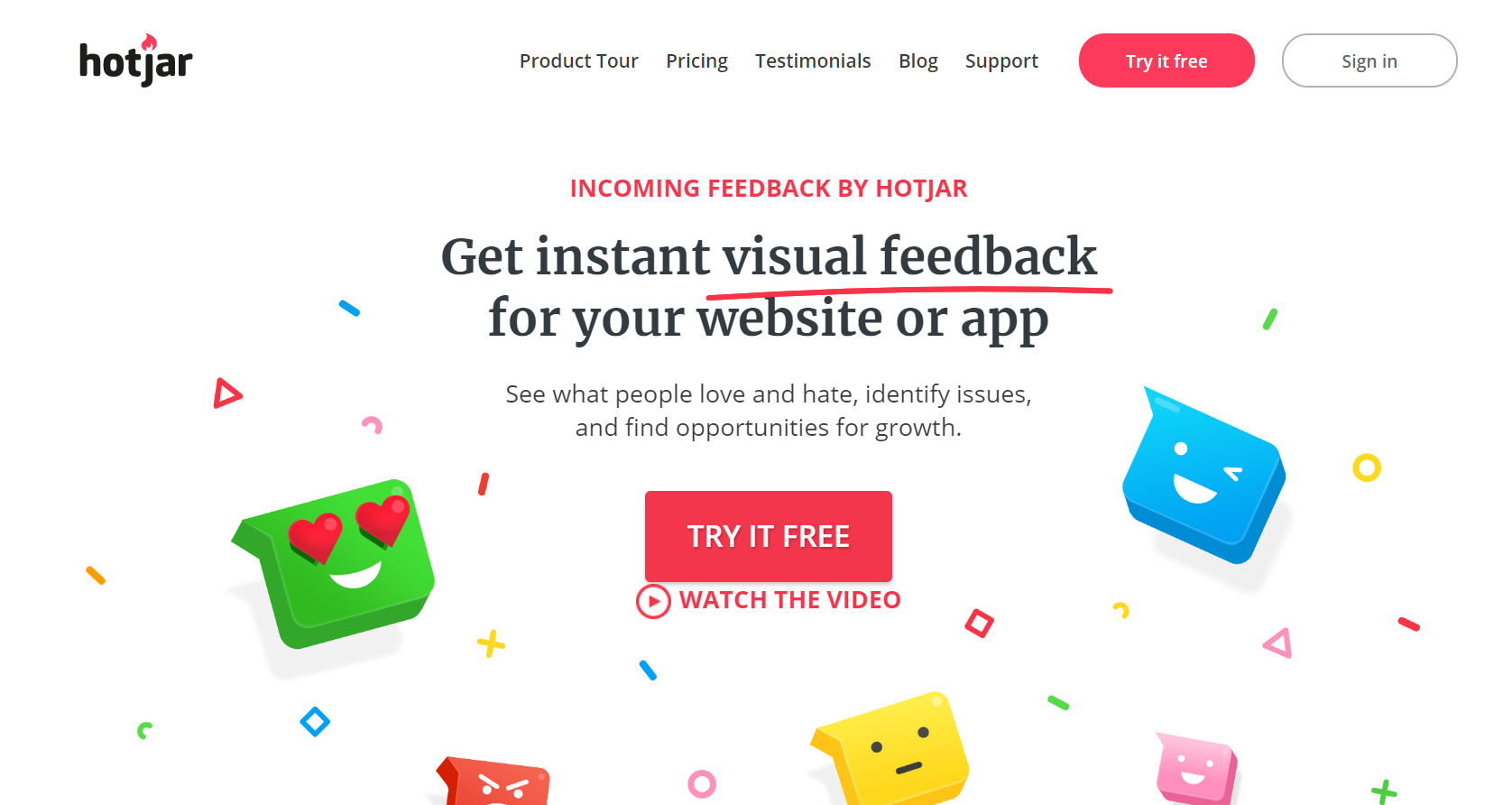
HotJar is a website behavior analytics and user feedback software that provides a range of advanced data collection and analysis tools. These include heatmaps, session recordings, and feedback surveys.
HotJar features:
- Create polls and questionnaires to collect user feedback after they visit a particular webpage or when they’re about to exit the website.
- Create surveys and send them to visitors after they leave your website.
HotJar pricing:
- The Basic (free) plan is ideal for websites with less than 2,000 page views per day.
- The Plus plan is ideal for early-stage startups that want to collect data for websites with less than 10,000 page views per day. The pricing for the Plus plan is $29/month.
- There is also a tiered pricing model for websites that receive large amounts of traffic.
4. Bazaarvoice
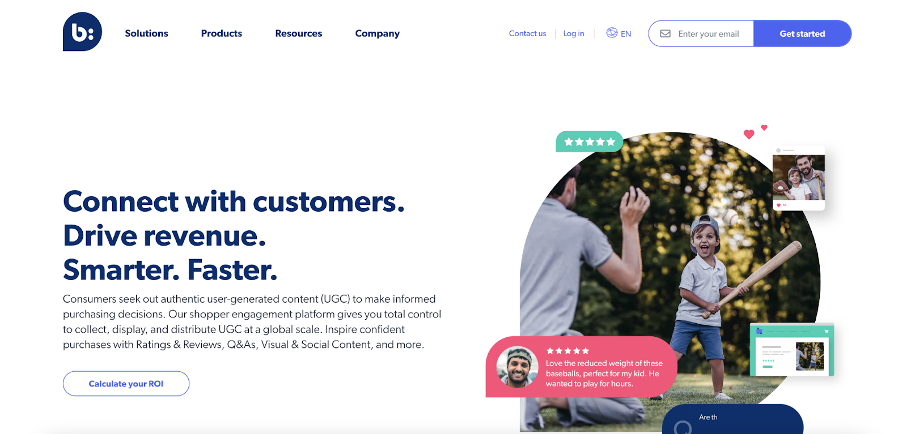
Bazaarvoice is a software that retailers and ecommerce companies use to add customer reviews to their websites.
Retailers can add product reviews, ratings, and customer-generated videos to their websites to increase credibility and social proof.
Bazaarvoice features:
- Use this Bazaarvoice feature to collect feedback and reviews from your customers.
- Display customer-generated content under specific products or categories to help boost sales and build brand loyalty.
- Shoppers can request and publish questions about a particular product or service. Do this to help increase engagement and sales.
Bazaarvoice pricing:
- Three different packages: Starter, Professional, and Enterprise.
- There’s no pricing information available or displayed on Bazaarvoice’s website. You can obtain this information only by contacting them directly.
5. Typeform
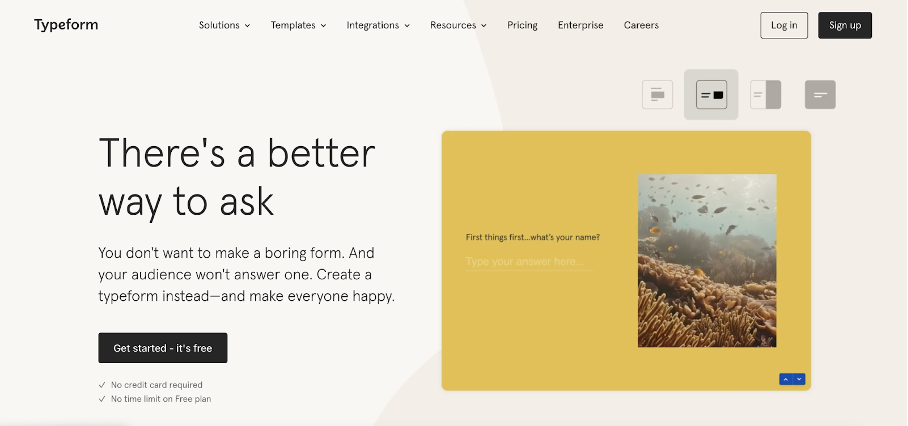
You can use Typeform to create and deploy contact forms, quizzes, feedback surveys, polls, and questionnaires with a simple and easy-to-build interface.
Typeform features:
- Create and customize interactive customer feedback forms.
- Add multiple question types (multiple-choice, open-ended, yes/no, picture choice, demographics, etc).
- Extensive library of templates and use cases, which you can customize and use for your own customer feedback surveys.
Typeform pricing:
- Three different plans (Basic, Plus, and Business).
- The pricing varies from 21 EUR/month to 75 EUR/month depending on the number of responses received, customization, integrations, etc.
6. Jotform Survey Maker
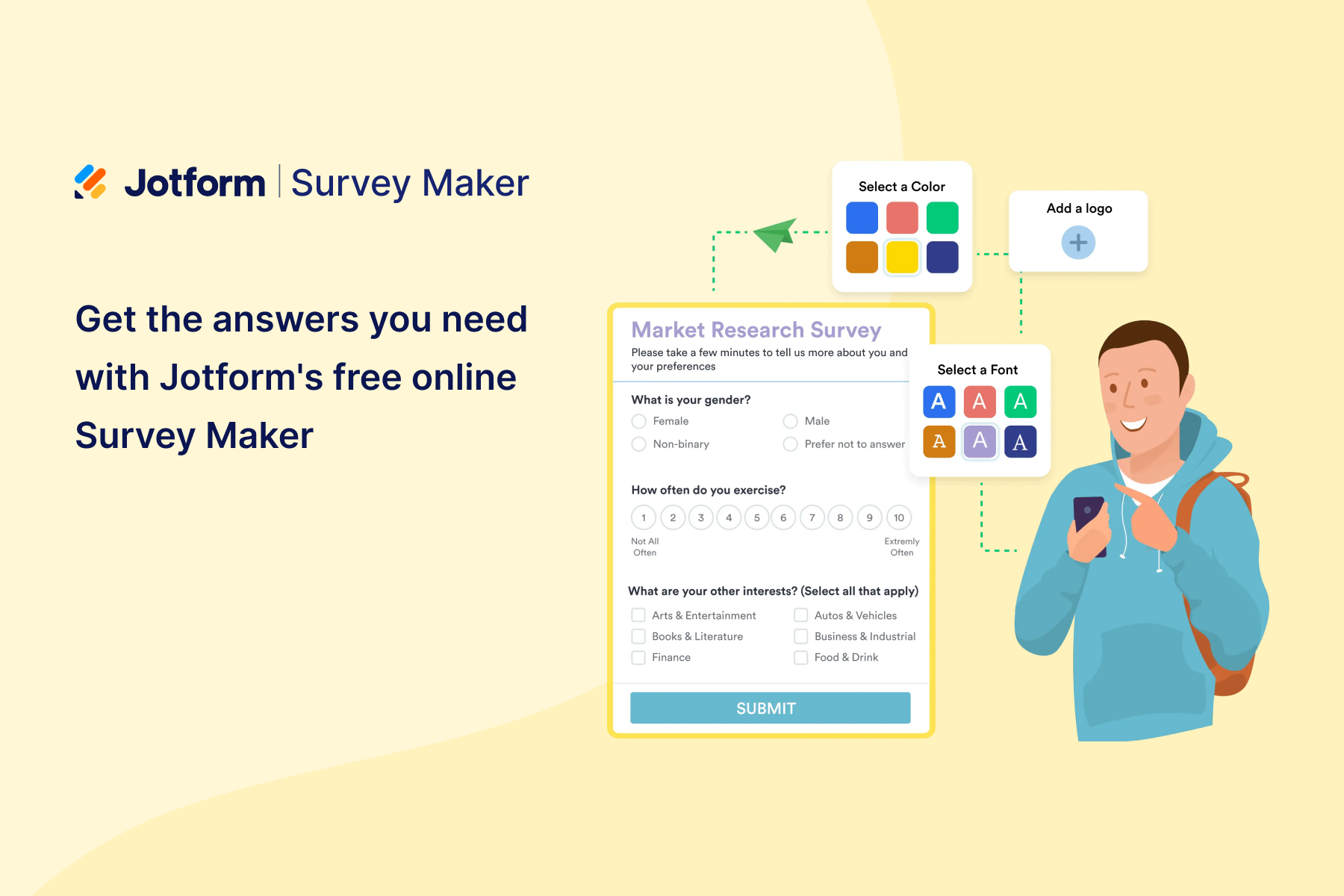
Jotform Survey Maker is a free online tool used to collect feedback, determine your audience, and analyze user data to gain beneficial insights.
Jotform features:
- Choose from tons of free templates to easily create your surveys according to your needs.
- Embed your surveys on your website or share them with just a link.
- Use their custom conditional logic to create a unique experience for every user.
- See your submissions on a beautiful spreadsheet to better understand and keep track of your data.
- The free plan includes all of Jotform’s features just with limited form creation and submissions.
- The paid models start from $24/month paid annually. You gain increased monthly submissions, more cloud storage space, and a higher form limit.
Wrapping up
Customer feedback is a goldmine of brand new insights into your brand, solutions, website, customer and sales experience, and marketing materials.
Use these unique evaluation survey questions, channels, and strategies to understand what your customers truly want.
Turn these responses into better customer experiences, more sales, and greater loyalty rates.
We hope you found these customer survey questions helpful!
